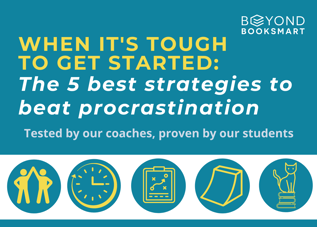Of all the Executive Function-related challenges we experience, procrastination is most pervasive. Even the most successful students and adults can struggle to initiate a difficult or less-than-exciting task. So what can they do about it? 
Plenty, it turns out.
This week, we’ll be sharing the 5 best strategies to conquer procrastination, all of which have been tested by our coaches and proven effective by the students and adults we work with. No reason to delay… let’s dive right in!
1. Buddy Up
One of the most difficult parts of starting something you’ve been putting off is the feeling that you have to tackle it alone. However, chances are your student knows someone who also has an assignment or task they’ve been putting off. Buddying up with a friend, sibling, or parent who needs to get some work done, too, is an excellent way to get over that initial barrier. Whether virtual or across the table, getting started is so much easier when you have some company!
2. Count it Down
Another difficult component of starting something is the transition away from a more preferred activity (and yes, that includes mindlessly scrolling through TikTok.) One great way to smooth the transition is by setting a timer for 15 minutes to help gradually set the stage for whatever that task is. This gives some extra time to do whatever you were enjoying, but it also can provide an opportunity to get in the zone by using that time to grab a snack or gather necessary materials. Better yet, make the 15-minutes into a game and see what you can accomplish before the timer is up.
3. Pair it Up
Work time doesn’t have to be all doom and gloom. Shift the association by pairing work with something fun and rewarding. A pet curled up by your side, a specific snack ready to go, or a nice playlist of chill music going on in the background (like this lo-fi one I’m listening to now) are all awesome ways to reduce the urge to avoid whatever you need to get done.
4. Plan it Out
Sometimes, getting started can feel impossible because there’s no plan for how to approach it all. But when there’s a way, there’s a will! Before starting whatever you need to get done, sit down and think through what needs to be done without the pressure of actually doing it yet, as well as what can wait for another day. Then map out when in your day you’re going to do it, including how long it will take and when you’ll take breaks throughout (seriously, no skimping on the breaks!) Creating a game plan for what to do and when, while also setting aside what can wait and when you’ll reward yourself with a break makes getting started infinitely easier.
5. Ramp it Up
When the to-do list is particularly long, it feels easier to avoid the whole thing. However, this just makes things so much worse in the long run. But the truth is, you don’t have to jump into the hardest thing all at once in a single work-binge. Instead, try to do the simplest tasks first to get into the work groove. Finding class notes, reading through an assignment, or knocking out an easy worksheet can get the ball rolling and make the rest of the work so much easier. By ramping up like this, you’ve already accomplished something!
The Takeaway
Procrastination is a pitfall we all battle, but with these strategies, hopefully you can reduce a whole lot of stress and bring back a sense of proactive confidence when it comes to tackling difficult tasks or responsibilities... because putting them off never helps!
Download our infographic of these tips to print out or share with someone you care about.
Photo by Katerina Holmes from Pexels


